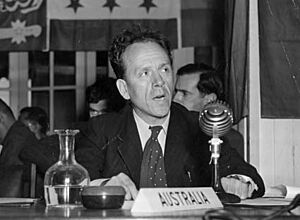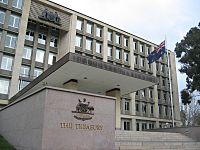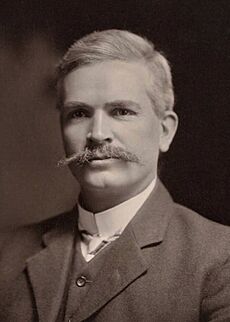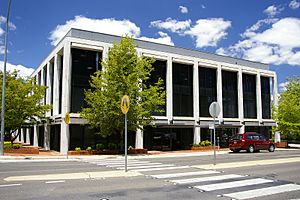Reserve Bank of Australia facts for kids
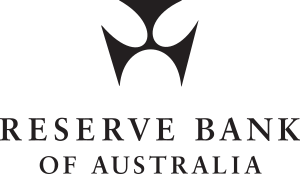 |
|
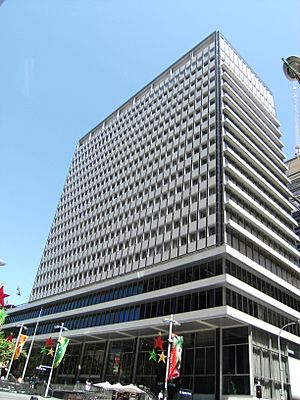
|
|
| Headquarters | Reserve Bank of Australia Building, Sydney |
|---|---|
| Coordinates | 33°52′05″S 151°12′42″E / 33.8681°S 151.2117°E |
| Established | 14 January 1960 |
| Ownership | 100% state ownership by the Australian Government |
| Governor | Michele Bullock |
| Central bank of | Australia |
| Currency | Australian dollar AUD (ISO 4217) |
| Reserves | $80,837 million (AUD) |
| Reserve requirements | None |
| Interest rate target | 3.85% |
The Reserve Bank of Australia (RBA) is like Australia's main bank. It's called a central bank. Its job is to help keep Australia's economy healthy. It also prints the Australian banknotes (the paper money!). The RBA has been doing this since January 14, 1960. Before that, the Commonwealth Bank handled these tasks.
One of the RBA's most important jobs is to control inflation. Inflation means prices for things like food and clothes go up over time. The RBA tries to keep inflation at a good level, usually between 2% and 3% each year. It does this by changing the official cash rate, which affects how much it costs to borrow money. This also helps manage how many people have jobs.
The RBA also helps the Government of Australia with its banking needs. It provides services to other central banks around the world too. The RBA has two main groups that make decisions: the Payments System Board and the Reserve Bank Board.
Both boards include people from the RBA, the Australian government's Treasury, and other important parts of the Australian economy. The head of the RBA is called the Governor. The Governor leads both boards and helps solve any disagreements they might have.
Contents
What the RBA Does
The Reserve Bank follows rules set out in the Reserve Bank Act 1959.
The RBA's main goal is to control inflation. It uses something called monetary policy to do this. Monetary policy is how the RBA manages the amount of money in the economy. Since 1993, the RBA has aimed to keep inflation between 2% and 3% on average over time. This target was first set by Governor Bernie Fraser. It was made official in 1996 by Treasurer Peter Costello and Governor Ian Macfarlane.
The RBA also offers banking services to government groups and other central banks. The bank holds Australia's gold and foreign money reserves. These are worth about A$101 billion.
Most of the RBA's employees work in Sydney, where its main office is. Other staff work in cities like Adelaide, Brisbane, Canberra, Melbourne, Perth, London, and New York City. The RBA also owns a company called Note Printing Australia. This company makes Australian dollars and other important documents for Australia and other countries.
The Payments System Board decides how the bank handles payments. The Reserve Bank Board makes decisions about all other money and banking policies. If these two boards disagree, the Governor steps in to make the final decision.
The Governor's Role
The Governor is the most important person at the RBA. The Treasurer of Australia chooses the Governor for a term of up to seven years. The Governor can be chosen again after their term ends. The Governor leads both the Payments System Board and the Reserve Bank Board. They also sort out any arguments between the boards.
The RBA Governor must stay in touch with the Treasury. They talk about things that affect both the Treasury and the RBA. The RBA board also tells the government about its money and banking plans. The Governor often meets with the Treasurer to do this. Since 1996, the Governor and other RBA leaders have met with the House of Representatives Standing Committee on Economics twice a year. They explain how the bank is doing its job.
Past and Present Governors
| * | Died in office |
| # | Governor | Start | End | ||||||||||||||
|---|---|---|---|---|---|---|---|---|---|---|---|---|---|---|---|---|---|
| Governors of the Commonwealth Bank of Australia | |||||||||||||||||
| 1 | Denison Miller | June 1912 | June 1923 | ||||||||||||||
| 2 | James Kell | October 1924 | October 1926 | ||||||||||||||
| 3 | Ernest Riddle | October 1926 | February 1938 | ||||||||||||||
| 4 | Henry Sheehan | February 1938 | March 1941 | ||||||||||||||
| 5 | Hugh Armitage | July 1941 | December 1948 | ||||||||||||||
| 6 | H. C. Coombs | January 1949 | January 1960 | ||||||||||||||
| Governors of the Reserve Bank of Australia | |||||||||||||||||
| 1 | H. C. Coombs | January 1960 | July 1968 | ||||||||||||||
| 2 | J. G. Phillips | July 1968 | July 1975 | ||||||||||||||
| 3 | H. M. Knight | July 1975 | August 1982 | ||||||||||||||
| 4 | Bob Johnston | August 1982 | July 1989 | ||||||||||||||
| 5 | Bernie Fraser | September 1989 | September 1996 | ||||||||||||||
| 6 | Ian Macfarlane | September 1996 | September 2006 | ||||||||||||||
| 7 | Glenn Stevens | 18 September 2006 | 17 September 2016 | ||||||||||||||
| 8 | Philip Lowe | 18 September 2016 | 17 September 2023 | ||||||||||||||
| 9 | Michele Bullock | 18 September 2023 | – | ||||||||||||||
H. C. Coombs served the longest as Governor, for almost 20 years in total across both banks. He was known for trying to keep inflation low. The longest-serving Commonwealth Bank governor was Sir Ernest Riddle (over 11 years). The longest-serving Reserve Bank governor was Ian Macfarlane (10 years). James Kell served the shortest time, only two years.
In July 2023, Michele Bullock was chosen as the new RBA Governor. She started in September 2023. This made her the first female Governor of the RBA.
The Reserve Bank Board
The Reserve Bank Board has nine members. Three of them are there because of their jobs: the Governor (who leads the board), the Deputy Governor, and the Secretary to the Treasury.
The other six members are chosen by the Treasurer for five years. These members cannot work for banks that take deposits. The board's structure has been mostly the same since 1951.
The current members of the board are:
| Name | Office (if applicable) | Term begins | Term ends | ||||||||||||||
|---|---|---|---|---|---|---|---|---|---|---|---|---|---|---|---|---|---|
| Members by Job Title | |||||||||||||||||
| Michele Bullock | Governor of the Reserve Bank (chair) | 18 September 2023 | 17 September 2030 | ||||||||||||||
| Andrew Hauser | Deputy Governor of the Reserve Bank (deputy chair) | 12 February 2024 | |||||||||||||||
| Steven Kennedy | Secretary to the Treasury | 2 September 2019 | Indefinite | ||||||||||||||
| Other Members | |||||||||||||||||
| Ian Harper | – | 31 July 2016 | 30 July 2026 | ||||||||||||||
| Carolyn Hewson | – | 30 March 2021 | 29 March 2026 | ||||||||||||||
| Iain Ross | – | 7 May 2023 | 6 May 2028 | ||||||||||||||
| Elana Rubin | – | 31 August 2023 | 30 August 2028 | ||||||||||||||
| Carol Schwartz | – | 14 February 2017 | 13 February 2027 | ||||||||||||||
| Alison Watkins | – | 17 December 2020 | 16 December 2025 | ||||||||||||||
The board usually meets eight times a year. These meetings happen in February, March, May, July, August, September, November, and December. This new schedule started in 2025. Most meetings are at the RBA's main office in Sydney. Sometimes, they meet in other Australian cities. At least five members must be present for a meeting to happen. The Governor or Deputy Governor must lead the meeting.
The board usually agrees on decisions without needing to vote. Meetings start at 9:00 am and last for about three and a half hours. A summary of the meeting is made public two weeks later.
Payments System Board
The Reserve Bank Act 1959 gives the Payments System Board the power to set rules for Australia's payment systems. This means making sure payments are safe, work well, and are fair for everyone. The RBA can make rules for how payment systems operate. If there are problems between members of a payment system, the RBA can help solve them. The RBA can also collect information from payment systems.
The Payment Systems and Netting Act 1998 helped make payment laws clearer. It changed old rules so that payments made on the same day could not be easily cancelled, even if a bank went bankrupt. This was important for systems where payments happen instantly. The RBA also works with the Australian Competition & Consumer Commission (ACCC). They make sure there is fair competition in payment systems.
The Payments System Board has up to eight members. Three members are there because of their jobs: the RBA Governor (who leads the board), a representative from the RBA, and a representative from the Australian Prudential Regulation Authority (APRA). Up to five other members are chosen by the Treasurer for up to five years. The board meets four times a year, usually in Sydney. At least five members must be present, and the Governor or Deputy Chair must lead the meeting. The RBA Chair and the ACCC Chair meet at least once a year to discuss payment system issues.
The current members of the Payments System Board are:
| Name | Office (if applicable) | Term begins | Term ends | ||||||||||||||
|---|---|---|---|---|---|---|---|---|---|---|---|---|---|---|---|---|---|
| Members by Job Title | |||||||||||||||||
| Michele Bullock | Governor of the Reserve Bank (chair) | 18 September 2016 | 17 September 2023 | ||||||||||||||
| Brad Jones | Deputy Governor of the Reserve Bank (deputy chair) | 16 January 2024 | 16 January 2029 | ||||||||||||||
| John Lonsdale | APRA representative | 1 November 2022 | Indefinite | ||||||||||||||
| Other Members | |||||||||||||||||
| Ross P. Buckley | – | 1 August 2023 | 31 July 2028 | ||||||||||||||
| Gina Cass-Gottlieb | 15 July 2013 | 31 July 2028 | |||||||||||||||
| Michelle Deaker | 1 August 2023 | 31 July 2028 | |||||||||||||||
| Scott Farrell | 23 March 2022 | 22 March 2027 | |||||||||||||||
| Deborah Ralston | 15 December 2016 | 14 December 2026 | |||||||||||||||
History of the RBA
Ideas for a national bank in Australia started in the mid-1800s. In 1911, the Commonwealth Bank was created. At first, it was a government-owned commercial bank, not a central bank. The Australian Treasury still printed banknotes.
After World War I (1914–1918), Australia tried to return to the gold standard. This meant that Australian money could be exchanged for a set amount of gold. This happened in 1925 for both the British and Australian pounds.
During the Great Depression in the 1930s, the Australian pound lost value. It was no longer tied to the British pound or the gold standard. In 1945, new laws brought more rules for private banks.
In 1959, the Reserve Bank Act 1959 was passed. This law officially separated the central banking jobs from the Commonwealth Bank. The Reserve Bank of Australia was created as a separate central bank. This change took effect on January 14, 1960.
In 1983, the Australian dollar started to float. This means its value is decided by the market, not set by the government. Around the same time, Australia's financial system became less regulated. In 1998, the job of overseeing banks moved from the RBA to a new group called the Australian Prudential Regulation Authority (APRA). The Payments System Board was also created to help keep payment systems safe.
In May 2022, the RBA increased interest rates for the first time in over ten years. This was done to fight high inflation. This decision caused a lot of discussion because it happened during a federal election campaign.
In November 2024, a new law was passed. This law split the RBA into two separate boards. One board now focuses on setting monetary policy (like interest rates). The other board handles the general running of the bank, such as its technology.
Heritage Buildings
Some buildings linked to the Reserve Bank are listed as important historical sites. These include:
- 20-22 London Circuit, Canberra: Reserve Bank of Australia Building, Canberra
- 65 Martin Place, Sydney: Reserve Bank of Australia Building, Sydney
See also
 In Spanish: Banco de la Reserva de Australia para niños
In Spanish: Banco de la Reserva de Australia para niños
- Australian dollar
- Australian Prudential Regulation Authority
- Bank Notes Tax Act 1910
- Banking in Australia
- Central bank
- Note Printing Australia
- Official cash rate
- Royal Australian Mint
- List of central banks


